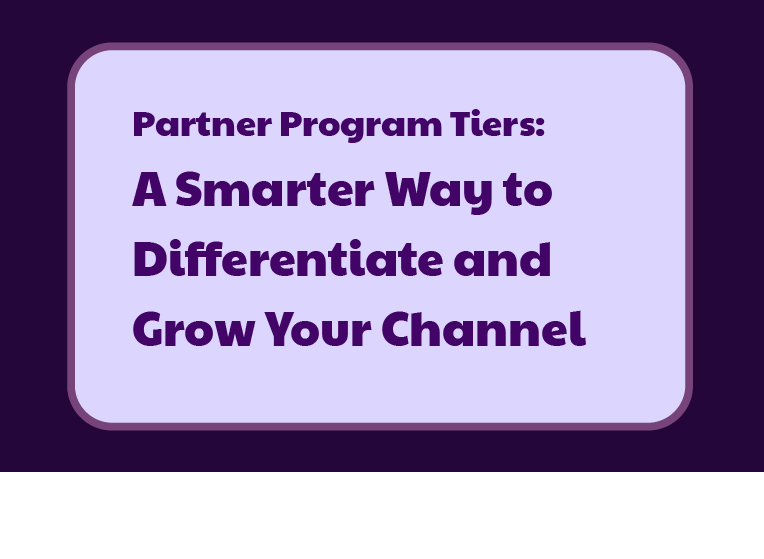- Why is a CRM integration the most important feature in a PRM?
- Your partner portal depends on a pristine CRM integration as its raison d'être – period.
- Why you should assess the CRM integration first before buying a PRM
- All PRMs (partner portals) integrate with Salesforce → but how?
- How to integrate CRM data to a PRM? Let's explore 3 different ways to do it:
- Who benefits most from a mirroring integration?
- Full value of such data accuracy & precision is deeply helpful for mature partner programs
- Zero-config CRM integration = fast PRM time-to-value
- CRM data: What's included?
- CRM schema: What's included?
- Part 1 of the consequences of not having a proper CRM-to-PRM integration: The data considerations
- Part 2 of the consequences of not having a proper CRM-to-PRM integration: The schema considerations
- Here's how you can assess it.
- There are 3 main points to think about when determining how the CRM-to-PRM integration will function in any PRM software:
- Fix 98% of your partner operations problems by using a PRM with a CRM mirroring integration
The CRM-to-PRM Integration Guide for the Unsuspecting Partner Portal (PRM) Buyer
A primary reason partner portals fail? A broken CRM-to-PRM integration. This guide exposes why most CRM to PRM integrations break under pressure, what red flags to watch out for. Partner Ops people: If you’ve ever had to manually fix a deal that went missing in Salesforce, this guide is for you.
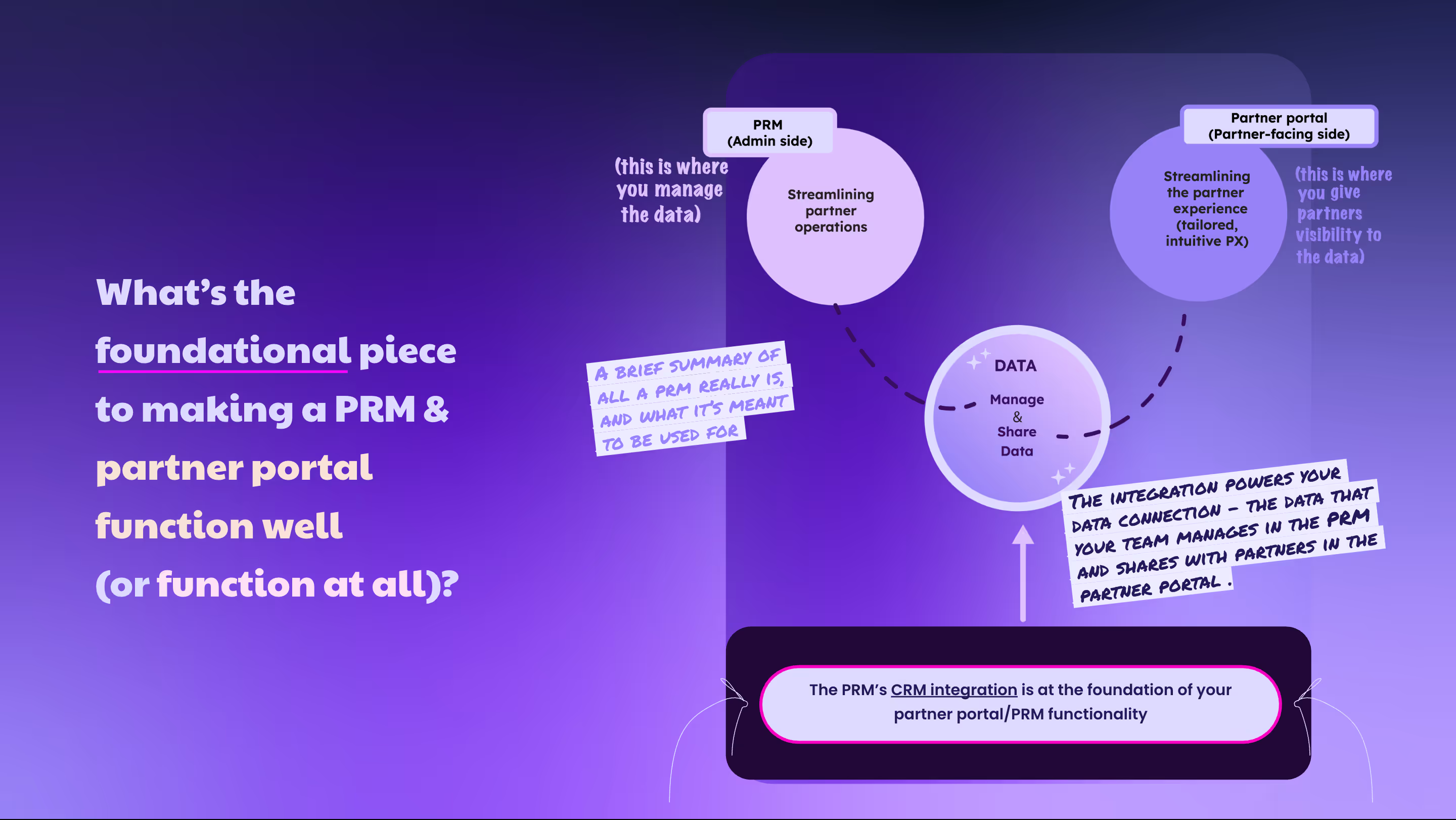
Table of Contents 📋
Table of Contents 📋
- Why is a CRM integration the most important feature in a PRM?
- Your partner portal depends on a pristine CRM integration as its raison d'être – period.
- Why you should assess the CRM integration first before buying a PRM
- All PRMs (partner portals) integrate with Salesforce → but how?
- How to integrate CRM data to a PRM? Let's explore 3 different ways to do it:
- Who benefits most from a mirroring integration?
- Full value of such data accuracy & precision is deeply helpful for mature partner programs
- Zero-config CRM integration = fast PRM time-to-value
- CRM data: What's included?
- CRM schema: What's included?
- Part 1 of the consequences of not having a proper CRM-to-PRM integration: The data considerations
- Part 2 of the consequences of not having a proper CRM-to-PRM integration: The schema considerations
- Here's how you can assess it.
- There are 3 main points to think about when determining how the CRM-to-PRM integration will function in any PRM software:
- Fix 98% of your partner operations problems by using a PRM with a CRM mirroring integration
(For the short summary of the guide, see the pdf format here.)
TL;DR abstract: If your CRM integration breaks, your PRM breaks. This is the #1 factor that makes or breaks your partner portal. Literally.
Why I made this guide: This guide is based on years of conversations the Magentrix team has had with channel teams and hearing about what their old PRM's CRM integration was like, as well as the pains it caused them vs. their experience with Magentrix's Salesforce integration. I heard over and over again that Magentrix's integration was "just amazing" but nobody could ever pinpoint exactly why or what made it so different or better.
They would often say things like "I can do so much more with it" or "The Salesforce integration was why we chose you" or "What a game-changer". I had to figure out why. So I launched an investigation and interviewed Vahid (CEO and architect of the integration) about every possible aspect of how he built our CRM integrations and why it's better than how alternative PRMs designed theirs.

Jayson Peterson
VP of Global Channels & Alliances at Magaya
"The Salesforce integration was simple and has proven to be the most beneficial feature. We needed a robust deal management system that integrates fluently with Salesforce, especially given our complex Salesforce environment. The integration had to be perfect – matching field to field – working through our reporting functions, and integrating into our existing processes. When one of our salespeople updates the pipeline, the information flows into the same reports and spreadsheets, reaching the board without a hitch.
With the pipeline already updated, I can focus on strategy rather than minutiae like sales stages or close dates.
So not only did we find this perfect integration to SF in your PRM, but we did it far quicker than expected. The process was straightforward: a few calls, testing, and we were done. This ease of implementation is highly underrated – especially compared to other PRMs we’ve used before. This seamless SF integration is a game-changer."
Read the review,or the case study

I realized something that isn’t talked about enough: channel operations, partner operations, and Salesforce admins deserve to know how to assess a PRM’s CRM integration before buying – as this is the fundamental, main thing the operational aspect of a partner portal revolves around – and it determines how many countless hours of your partner ops team's time is spent troubleshooting the PRM.
Why is a CRM integration the most important feature in a PRM?
A PRM, or partner portal, is software designed to streamline your channel and partner operations (e.g. deal registration, deal status updates, visibility for partners into reports, tailored communications to various partner segments, role-based sharing permissions, etc).
And central to how effectively it can streamline your partner ops (or partner rev opers) is the integration between your CRM and partner portal (PRM) systems.
So if you’re in channel or partner operations, many of the outcomes you may be trying to achieve pivot around this central facet – whether you realize it or not.
Your partner portal depends on a pristine CRM integration as its raison d'être – period.
This connection is fundamental – without a seamless CRM-to-PRM integration, the partner portal simply cannot deliver on its promise to simplify and improve your partner management processes.
👉 Without a proper integration, the PRM and partner portal essentially become useless.
Why? Because the CRM integration serves as the backbone for many of the day-to-day functions that a PRM is intended to support.
However, creating a reliable CRM-to-PRM integration is complex and most PRMs on the market haven’t been able to get it right and achieve a reliable connection.
↳ Their integrations often rely on brittle field-mapping and shallow syncs that break often and especially under scale – leading to:
- data drift,
- partner frustration,
- and heavy admin overhead
(more on these challenges later – or skip ahead now)
Preview: Here's a video walkthrough with a short summary of all the different CRM-to-PRM integration types discussed in this guide:
Why you should assess the CRM integration first before buying a PRM aka partner portal software
How the CRM-PRM integration has been built is something most buyers don’t think about examining in detail (if at all) when setting out to search for a partner portal.
It’s often an overlooked part of the PRM buying process but it’s actually the most critical component to selecting the software vendor that can meet the expectations you’d have from a PRM or partner portal.
Prevent expensive, headache-inducing migration from one PRM to another
Many partner teams don’t realize it, but the problems caused by a poor integration are often the main reason that forces them to switch from one PRM to another, in hopes they’ll find one that works as expected.
(More on these challenges as you read on.)
Prevent expensive, headache-inducing migration from one PRM to another by conducting a thorough assessment of the way the CRM integration’s been done.
Important note:
- While this isn’t such a big deal when it comes to earlier-stage partner programs, it begins to become a huge headache and source of growing operational challenges as you scale your partner program.
- So for partner teams with complex partner operations (usually found at upper mid-market and larger enterprise levels), it is of fundamental importance and cannot be ignored (fair warning: if you do ignore it, scaling your partner operations and thus, your partner program will be very difficult if not impossible.
All PRMs (partner portals) integrate with Salesforce → but how?
Sure, all PRMs do integrate with Salesforce (and a number of other CRMs). But how it does so is the most important consideration to pay attention to when figuring out if a PRM is right for your needs.
You might think, “Oh but I saw them listed on Salesforce AppExchange – that must mean their integration is solid, right?” – not quite.
No, just because you find a certain PRM on the AppExchange, it doesn’t mean their CRM integration has been built well or won’t give you any syncing problems.
↳ All it means is that the integration has been AppExchange-approved, suggesting it's optimized for routine operations and respects Salesforce best practices (e.g. passing Salesforce’s security review).
So, going back to the previous point – if your needs are that:
- Preferably, you don’t want the configuration to take weeks or months.
- You need to bring over your data from your CRM to the PRM, exactly as it is
- You don’t want to have to rebuild your data and its logic in the PRM
- You need to give partners visibility and access to up-to-date, reliable, accurate data from your CRM that pertains to them
- You don’t want to manage data in two places (in both the CRM and the PRM)
- You want to be able to make updates easily – and have your own team handle it – rather than relying on the PRM vendor every time you need to make a change.
- You don’t want to do any maintenance work to ensure the integration continues to work (i.e. you want to avoid constant sync issues)
Then be sure to read on and learn how to assess a PRM software vendor’s CRM integration because even though that all sounds like reasonable expectations to have as a buyer, right out of the box – the fact is:
Not all PRMs can do all the above for you. In fact, most can't (and if they do, it will cost you – a lot – in time and money).
Key takeaway: Just because a PRM advertises that they have a Salesforce integration, doesn't mean it's the best portal option for the job. The best portal for the job is the one that can achieve true CRM parity.
How to integrate CRM data to a PRM? Let's explore 3 different ways to do it:
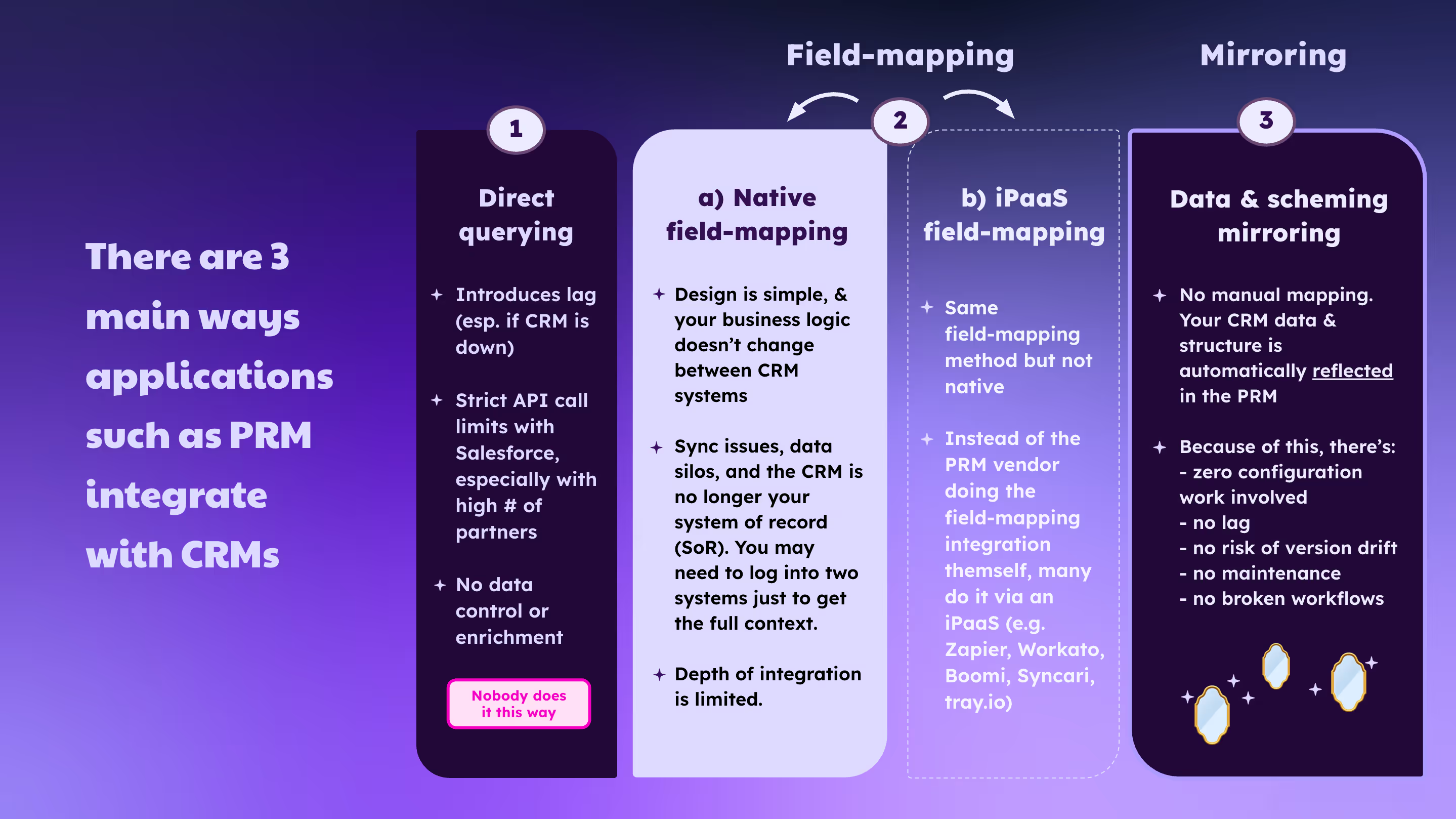
Integration method #1: Direct Querying
This approach connects the PRM directly to the CRM, querying data in real time whenever a partner requests information.
You’ll quickly run into API governance limits, and the performance hit is significant.
Every time your PRM needs to look up a deal, opportunity, or any other record, it has to reach back into the CRM, which adds unnecessary delays and slows down the user experience.
This approach rarely works in practice and most applications avoid doing the integration this way for this reason.
Integration method #2: Field-mapping - What is field-mapping from a CRM to a PRM?
If you remember one thing: Field-mapping = breaks often, high-maintenance, constant sync issues & data silos.For a PRM that uses the field-mapping method, this means in order for you to configure the integration, your team will have to map data fields from one application to another.
So in this case, you have to match up one field from the CRM with the matching field in the PRM (or find the closest matching field)
For example:
- When you need to upload a list from your CRM to your marketing automation or sales outreach platform, you need to match up the corresponding fields.
This method of integration can present some problems, and it’s not a big deal in most integration cases with other applications, but when you’re integrating between a CRM and a PRM this way – those problems become very noticeable and present many challenges to your workflows.
Some of the headaches a field-mapping integration may cause you, include:
- The amount of time it will take to configure the PRM to match what’s in your CRM.
- The fact that you can’t even bring over all your data from your CRM to your PRM.
- The regular trouble-shooting you’ll have to go through in order to maintain the integration, and when you need to make schema changes – such as, if you need to add a new field or if you want to change a field from not required to required:
For example, your partner might register a deal but it doesn’t make it to your CRM. - And when this happens, you’ll wonder why it doesn’t work.
- You’ll just reach out to your PRM vendor and ask them to fix it.
- And while the PRM vendor is working on that, you have to go and manually bring that deal from your PRM to your CRM,
↳ That’s if you even realize your partner registered a deal.
↳ Breaks your partner portal: And this essentially renders your partner portal useless for its core functionality.
In 99% of cases (with customers I’ve talked to), the cause behind such a problem is due to the CRM-to-PRM integration.
Most PRM admins won’t realize what’s causing the issue, but the way your PRM vendor has built their CRM integration is likely what’s at the heart of the problem.
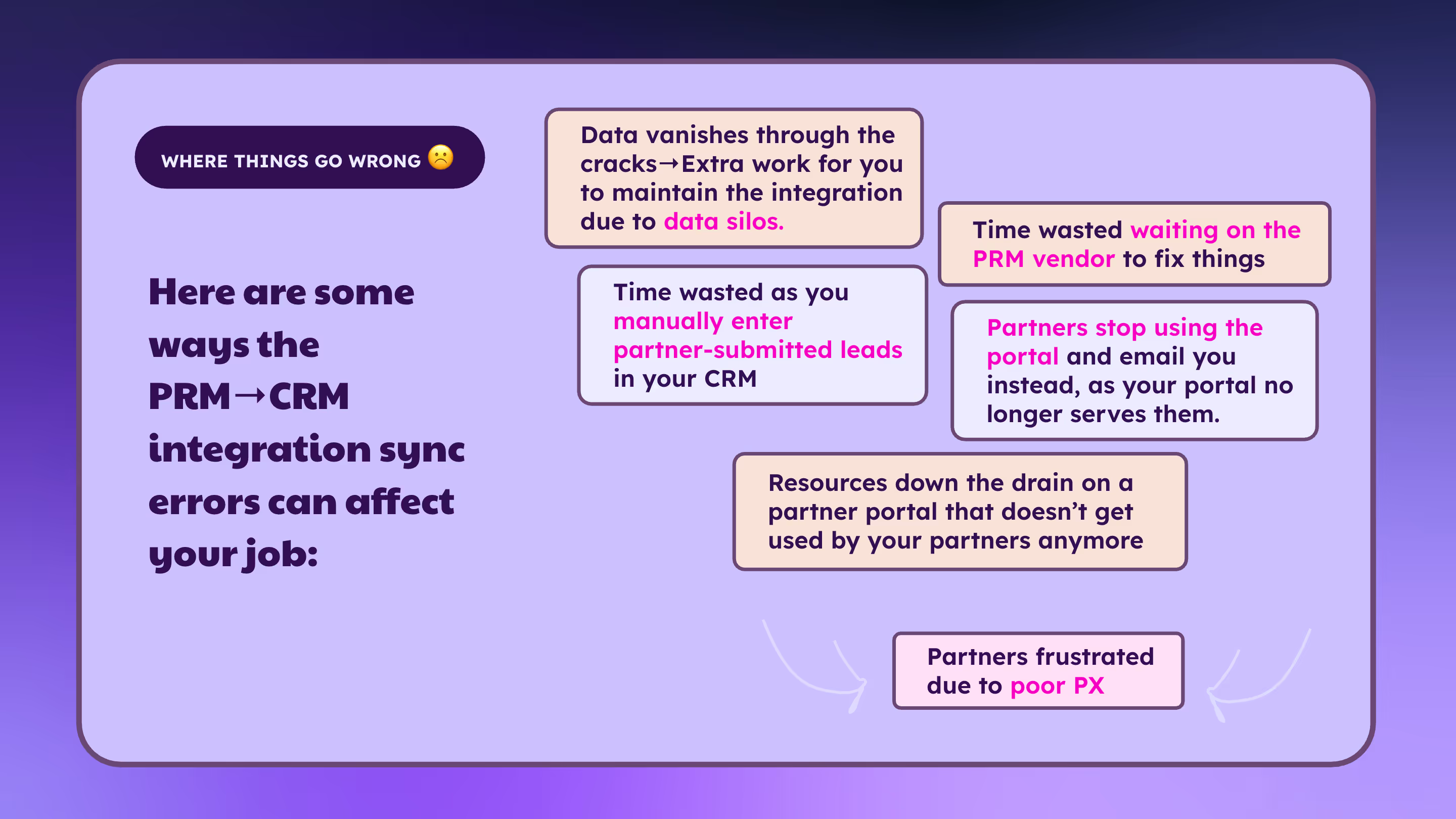
How will the impact look like when you experience the problems a field-mapping CRM-to-PRM integration can cause you?
- Repetitive day admin work – Every time your CRM changes, you redo some aspect of the tedious setup. Again. And again.
- The awkward family reunion – Related records (like contacts and accounts) lose track of each other, so your reports are full of “Who’s that again?”
- Fashionably late data (and partners waiting on you) – Partner updates made in the PRM show up in the CRM hours later… if they show up at all.
- Vanishing data & frustrated partners – Some data never makes it through the mapping at all, and no one notices until a partner says, “I swear I sent that!”
- Spreadsheet season – Reporting becomes a manual export–merge–pray ritual because the two systems never quite agree.
There are 2 common ways to achieve a field-mapping integration:
- One is to build it natively within the PRM application.
- The second is to for the PRM vendor not to build the integration but rather, achieve the integration via an iPaaS provider, such as:
Native vs. iPaaS field-mapping - What's the difference?
I always say: Don’t let the term “natively-built” fool you – because whether the CRM integration is natively-built or not, it’s still a field-mapping integration either way, and you’ll still have the problems that come with field-mapping.
Therefore, there’s ultimately not a whole lot of difference – but there is still one difference to be aware of:
- Doing the integration via iPaaS may be even worse because you are introducing a middle man and with that can come more complexities.
- And troubleshooting becomes more challenging too.
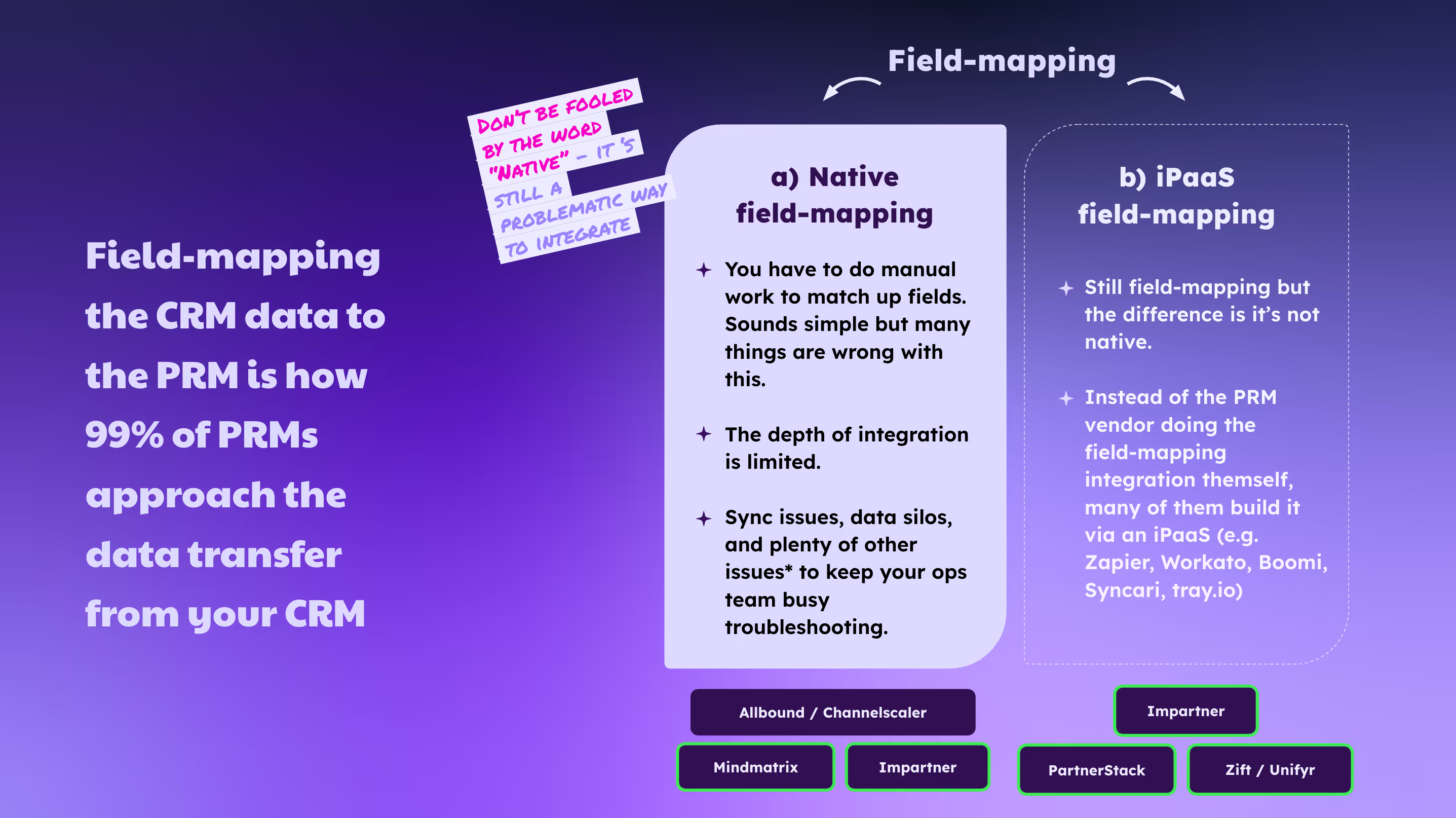
More on field-mapping woes: What are some signs that your PRM-to-CRM data flow needs attention?
Data silos.
You may notice partner-submitted information isn’t making it into your CRM – like when a partner registers a deal in the partner portal, but your sales team never sees it in the CRM.
This can happen due to sync issues, incomplete records, or broken relationships between objects. And often, it’s not something you can fix yourself – you’d have to go back to the PRM vendor for support, repeatedly.
What happens when this continues?
You face delays, duplicate work, frustrated partners, and an operations team that spends more time troubleshooting than on strategic work.
And you might even be experiencing: Partner pipeline leak™ – a term I coined myself 🙃
- What is partner pipeline leak™? Lost partner pipeline due to frustrated partners who can’t use the partner portal to successfully submit a deal.
- So perhaps, they don’t try anymore and maybe they plan to email it to you but it falls off their radar.
- Or they end up sending it to a competitor.
Which PRM vendors rely on field-mapping rather than mirroring? All of them except Magentrix. Here are some that I've done research on (read their documentation, case studies, feature descriptions, etc.):
- Allbound aka ChannelScaler
- Impartner
- Mindmatrix
- PartnerStack
- ZiftONE aka Unifyr
I strongly recommend further reading on the following sections to learn more about how a poorly-built CRM integration can impact your workflows and regularly create operational hiccups or other technical work for your team:
- Consequences of field-mapping instead of data mirroring
- Impacts of a PRM not reflecting your CRM schema accurately
Integration method #3: Mirroring data & schema 🪞✨
Key takeaway: Mirroring is the only method that scales without sync headaches. Everything else = Band-Aid fixes.
The best integration method is data & schema mirroring – which literally means mirroring your CRM data & schema to your PRM. With a mirroring integration, there is no field mapping.
So how is it done? Do we hold up a mirror to your CRM and call the mirror your PRM? No. But it’ll feel that way.
So when we say your data from your CRM is reflected into your PRM – it’s not just a cute choice of words, we literally mean it’s reflected. ✨
Magentrix’s mirroring integration will take the data & schema from your CRM and it will replicate it in your PRM, that means everything (e.g. custom objects, record types, rules, field logic, etc.) in your CRM are identical to your PRM. There are no differences.
- There are no predefined schemas → Schema is built based on what’s in your CRM.
- Therefore, there are no data silos and 98% less sync errors (our estimate based on our customers’ experiences with all the other PRMs they used to use).
Note: This method of CRM integration is rare to come by in most applications that exist because it’s much harder to build it this way.
↳ Magentrix is the only PRM on the market that has built its integration this way, and we built it this way since day one. (Fun fact: No other PRM takes the mirroring approach – not even close. The only platform that offers this level of data precision is Salesforce’s own Experience Cloud.)
Who benefits most from a mirroring integration?
Anyone can benefit from this type of integration – as it makes your partner operations tasks more streamlined and eliminates 98% of tasks you’ll have to look after and sync errors other PRMs cause you.
However, this type of integration is particularly great for those who have mature partner programs, which are usually enterprise companies.
Full value of such data accuracy & precision is deeply helpful for mature partner programs, with mature partner operations
If you have an early-stage partner program, you likely won’t see the full value of this integration because your partner operations are not yet complex enough to require the level of automation Magentrix’s CRM mirroring provides.
But if you’ve got mature partner operations, and you constantly have sync issues in your PRM and partners aren’t even able to register deals because it doesn’t make it over to your CRM, then data and schema mirroring is for you.

Zero-config CRM integration = fast PRM time-to-value
And due to the fact that everything is mirrored, setting up the connection takes just 5-8 minutes (with Magentrix).
Unlike other PRMs that take months to configure your CRM integration and don’t even come close to bringing your data the way Magentrix can, and that’s just the data, they can’t even bring your schema.
CRM data: What's included?
Here’s a list of what’s included when we say a PRM “reflects data” from your CRM:
- Records
- Standard objects (Accounts, Contacts, Leads, Opportunities, Campaigns, Cases, etc.)
- Custom objects you’ve built for your partner program (MDF Requests, Training Completions, Partner Tiers, Business Plans, etc.)
- Fields & Values
- All standard and custom fields on each object.
- Field data types (picklists, lookups, dates, text, currency, etc.).
- Current values for every field (what the record actually says right now).
- Relationships
- Object relationships (Lookup, Master-Detail, Junction objects).
- Which records belong to which parent (e.g., an Opportunity tied to a specific Account).
- Metadata that impacts data context
- Record Types (so the PRM can show different layouts or options based on type).
- Picklist values (and which ones apply to which record types).
- Default values configured in the CRM.
- Status & History
- Current record statuses (e.g., Opportunity Stage, Lead Status).
- Optional: Audit history (last modified date, who updated it).
- Permissions Context
- Field-level security and visibility rules from the CRM (so the PRM only shows what each partner is allowed to see).
It’s not just the data values – it’s the full picture of records, structure, relationships, metadata, and visibility rules, so the PRM feels like an extension of your CRM, not a half-baked copy.
CRM schema: What's included?
The schema defines the structure, rules and relationships of your CRM data. Think of it as the blueprint that tells the system what data exists, how it connects, and how it's supposed to behave.
Here's a clear breakdown of the relevant CRM schema that should be mirrored in your PRM (specifically Salesforce, but applicable to most CRMs):
Schema category 1 - The data model: The fundamental structure of data in the CRM - what types of records exist and how they relate.
1. Objects - these are the major record types (like database tables):
- Standard objects: Account, Contact, Lead, Opportunity, etc.
- Custom objects: Anything you've defined (e.g., Partner Tiers, Business Plans)
2. Record types - variations of the same object used to display different fields, layouts, or logic.
3. Relationships - how objects relate to one another:
- Lookup relationships
- Master-detail relationships
- Many-to-many relationships (via junction objects)
- These control how data rolls up, how it's linked, and how it can be accessed in related lists or reports
4. Fields - The individual data points that live on objects:
Standard fields (e.g., Opportunity Stage, Close Date)
- Custom fields (e.g., “Partner Region,” “MDF Amount”)
- Includes:
- Data types (text, date, picklist, checkbox, lookup, formula, etc.)
- Field-level help text
Schema category 2 - Field logic: Rules and behaviors that control how individual fields function, validate, or interact with each other.
1. Picklist values: Defined lists of acceptable values for dropdown fields – often unique per record type.
2. Formula fields: Auto-calculated fields that depend on other data (e.g., “Total Margin = Revenue - Cost”)
3. Required fields & default values: Controls for what must be filled out and what pre-populates (which fields are required and if some fields are not required, it will just automatically fill in with whatever that's configured in the CRM to be the default value).
Part 1 of the consequences of not having a proper CRM-to-PRM integration:
If you only skim this section, here’s the point:
- Field-mapping = regular sync errors, constant manual upkeep, bad data, data silos, broken automations, and frustrated partners.
- Mirroring = eliminates 98% of these problems.
What can go wrong if your partner portal does the CRM integration via field-mapping instead of data mirroring?
Field-mapping creates ongoing risks, costs, and confusion.
Field-mapping (i.e., syncing or recreating fields manually between CRM and PRM) might work at first, but it creates a fragile, high-maintenance setup that will keep you in a loop of operational hell and you’ll just have to deal with it and their unfortunate consequences (e.g. erodes data quality and partner visibility to that data – causing a terrible PX, slowing partnerships growth, and breaking trust with partners – and in the worst case, even losing partners).
Mirroring is the only model that scales cleanly, accurately, and securely with your CRM.
1. Constant manual upkeep
What happens: You have to manually define and map every object and field you want to sync – one by one.
Impact:
- Every time you add a new field in Salesforce, you must reconfigure the sync rules in the PRM.
- Human error is inevitable (wrong mappings, missed fields, or broken logic).
- It’ll feel like you’re getting punished for scaling: Admin burden increases as your schema evolves (you’ll also likely have to pay extra to get your PRM aligned to your CRM changes)
2. Data loss and incomplete records
What happens: If a mapped field is missing, renamed, or incompatible, sync fails silently or partially.
Impact:
- Partners submit complete data, but only partial data reaches the CRM.
- CRM workflows break due to incomplete records.
- Leads to partner frustration: “I already submitted that info!”
3. Broken relationships between objects
What happens: Mapped systems often fail to preserve relational integrity (e.g., which Contact belongs to which Account, or which Partner is linked to which Opportunity).
Impact:
- Records appear disconnected or orphaned in the CRM.
- Reports and workflows break due to missing links.
- Admins have to manually clean up relationships.
4. Limited custom object support
What happens:
Field-mapping setups often support only standard objects (Leads, Opportunities, Accounts), and custom objects require special configuration.
Impact:
- You can't fully extend your channel program into business plans, MDF requests, or partner scorecards.
- Limits how much of your CRM your partners can actually access.
- Forces workarounds that slow everyone down.
5. Misaligned reporting and attribution
What happens:
Because CRM and PRM hold different copies of data, reporting requires reconciliation.
Impact:
- Attribution for pipeline, partner-sourced revenue, and MDF impact gets messy.
- Finance and RevOps teams lose confidence in the numbers.
- QBRs and performance reviews become stressful.
6. Difficult to scale
What happens: As your program grows (more partners, more workflows, more objects) the manual mapping grows exponentially.
Impact:
- Every iteration costs time and money.
- Your portal becomes harder to maintain and slower to evolve.
- Eventually, teams consider rebuilding or migrating to a new system.
Part 2 of the consequences of not having a proper CRM-to-PRM integration: The schema considerations
Why does it matter if a PRM or partner portal doesn't reflect your CRM schema accurately?
A PRM that doesn’t reflect your CRM schema accurately isn’t just annoying – it:
❌ complicates your partner operations (e.g. it breaks workflows, pollutes data, etc),
❌ increases workload
❌ slows down your entire partner program
1. Automation failures
- When a PRM doesn’t reflect your CRM schema accurately, the automations you’ve built inside Salesforce (e.g. lead routing, approval flows, or pipeline updates) can quietly break.
- That’s because the data coming from the PRM may be incomplete, invalid, or missing required fields, which causes sync errors or skips steps entirely.
- As a result, critical workflows may never trigger, and no one notices – until:
- deals are stuck,
- partners are waiting,
- or something goes off the rails downstream.
2. Bad data quality and data drift
- Fields may be missing or mapped incorrectly, so data in the PRM and CRM fall out of sync.
- Partner-submitted data may override or conflict with core Salesforce records.
- Custom validation rules in Salesforce may be bypassed, allowing dirty data in.
3. Increased admin work
- Teams have to maintain separate logic in two places: CRM and PRM.
- Every schema change in Salesforce (new field, object, record type) has to be manually recreated and tested in the PRM.
- Over time, this becomes a huge operational tax.
4. Misaligned reporting and attribution
- If fields don’t match between systems, reporting becomes unreliable.
- You can’t confidently track partner-sourced pipeline, or program performance.
- Forecasting and ROI metrics break down.
5. Slowed time to value
- The partner portal launch gets delayed because every object, field, and rule has to be rebuilt manually.
- Iterating or scaling becomes painful as the PRM and CRM drift further apart.
Here's how you can assess it.
There are 3 main points to think about when determining how the CRM-to-PRM integration will function in any PRM software:
TL;DR overview:
- Time to integrate: If it takes more than a week, you’re buying admin pain. Ideally it should take 5 mins to bring over everything.
- Accuracy of data & schema: If it can’t mirror dependencies, field logic and record types, it’ll cause various types of errors and break workflows.
- Ease of maintenance: If every CRM change means more vendor tickets, you’re stuck.To understand what to look for, and what challenges you might face, it’s important to take time to assess how well the CRM-to-PRM integration will perform in any PRM software you’re considering using.
These are the 3 main factors to consider and ask the PRM vendor about when assessing how easily, accurately and reliably their PRM and partner portal will connect to your CRM data:
🛠️ 1. Configuration & time spent to integrate.
With Magentrix, it takes 5-8 minutes and works like magic. With other PRMs? Who knows (actually, their former customers that came to us know 😉 that’s how I know this is a widespread problem).
First, ask: Do you mirror my CRM’s structure automatically, or do I need to map everything manually? 99.8% chance they will say it’s field-mapping so you’ll have to map all your data manually.
| Question | How to validate 💡 & potential 🚩 red flags (Field-mapping PRMs) | Data mirroring PRMs |
|---|---|---|
| How long does a typical field-mapping configuration take for an enterprise use case? |
🚩 “It depends” with no clear estimate may hide complexity. 💡 Ask for real-world timelines for enterprise customers or case studies. |
No field-mapping involved; zero-config. e.g., Magentrix setup takes 5–8 minutes. |
| How much of the integration is out-of-the-box vs. custom-built? Does initial sync include historical data? | 🚩 They mention “defining sync rules” for every object → high maintenance. | Everything is mirrored out-of-the-box; historical data comes over. |
| Who owns initial setup? |
🚩 Relies on professional services rather than self-service. 💡 Ask for a RACI (roles/tasks). 💡 Validate with customer references (who did the work, how long). |
Configured automatically during initial deployment. |
| What if a CRM field/object has no PRM counterpart? |
🚩 “You’ll need a workaround.” 💡 You want a flexible schema; ask for a live example of adding a field and mapping it. |
Everything is mirrored; the “counterpart” concept is irrelevant. |
| Are custom fields/objects supported? Can admins create them? |
🚩 Not DIY / “requires custom code.” 🚩 Only standard objects unless you pay extra. 🚩 File tickets / wait weeks for changes. 💡 Admins can add fields/objects via UI. Ask about dynamic/custom objects, UI configurability, and request sandbox access. |
Anything you select is mirrored with its logic; no extra creation required. |
If custom fields can’t be mapped accurately, it could be risky:
| Factor | Risk Level if Custom Fields Can’t Be Mapped |
|---|---|
| Multi-tier partner programs | 🔴 High |
| Partner segmentation by region or vertical | 🔴 High |
| Complex incentive or training logic | 🔴 High |
| Basic reseller-only programs | 🟡 Medium |
| PRM used just for content delivery | 🟢 Low |
I brought the receipts: Video of Magentrix’s zero-config CRM-to-PRM integration
Need proof that our integration is really that easy? No problem – we have the receipts. Watch the video to see that it really takes 5-8 minutes to set up Magentrix’s Salesforce CRM integration in the PRM (sidenote: we also have the same type of CRM integration with Microsoft Dynamics).
🎯 2. Assess the level of precision in reflecting your current data and schema: How accurately does it bring over your data?
| Question | How to validate 💡 & potential 🚩 red flags (Field-mapping PRMs) | Data mirroring PRMs |
|---|---|---|
| How do you support object dependencies & record types (rules, logic, relationships)? |
🚩 “You’ll need to redesign those in the PRM.” 🚩 No record-type structure → lost CRM logic. 💡 Test real relationships (two related objects with dependency intact). 💡 Verify record types and conditional layouts/logic. 💡 Check rule inheritance (CRM validation rules respected?). |
This is part of your schema mirrored automatically during setup. |
| Can we sync related objects (Accounts → Contacts → Opportunities → Leads)? | 💡 Look for parent-child support and multi-level relationships. | Any object brought over is automatically synced. |
| Are picklists/multi-selects, dates, and relational fields synced correctly? |
🚩 “We only support basic field types.” 💡 Ask for a field-type compatibility matrix or example. |
Complex field types are mirrored and synced. |
| Are custom fields usable in PRM logic (segmentation, workflows)? |
🚩 “No, we cannot action custom fields.” 💡 Ask to see a workflow triggered by a custom field. |
Custom fields are native & fully actionable in the PRM. |
🔄 3. Assess the ease of maintaining the flow of data from the CRM to the PRM (this is what will save your partner operations team lots of time throughout the lifetime of using your PRM).
A mirroring integration, such as the one Magentrix has, makes it easy to maintain clean, reliable data flow between your CRM and PRM because our integration is built differently (actually).
When you use a PRM that mirrors both your data and schema, it makes a huge difference for your partner operations.
Here’s a shallow picture of what CRM data flow maintenance can commonly look like within most other PRMs:
- Constant reconfiguration: Every time your CRM changes (new fields, objects, picklist values), you have to remap them manually in the PRM.
- Sync babysitting: Scheduled sync jobs fail or get delayed, so you’re constantly checking if data made it through.
- Mismatched rules: Validation rules, dependencies, and record type logic in the CRM aren’t replicated in the PRM, leading to errors and rejected records.
- Broken relationships: Contacts lose their link to accounts, deals lose their partner association, and reports become unreliable.
- Data drift cleanups: Periodic “data reconciliation projects” to fix misaligned records between systems.
Partner complaints: Partners chasing down missing deal statuses or asking why the portal shows outdated information.
| Question | How to validate 💡 & potential 🚩 red flags (Field-mapping PRMs) | Data mirroring PRMs |
|---|---|---|
| If we add new fields/objects later, can we sync them easily — including historical data? |
🚩 Downplays schema changes / “file a ticket.” 💡 Look for dynamic mapping; how long to add a field? vendor needed? 💡 Ask for sandbox access to verify historical data. |
Entire object re-synced; historical data is brought over. |
| Is there an error log or notifications for failed syncs? |
🚩 Manual log checks; no UI. 💡 Proactive alerts with an example dashboard. |
Automatic error notifications; historical log available. |
| How do you handle Salesforce API limits / throttling? |
🚩 “It rarely happens.” 💡 Should use bulk APIs, retries, or batching; ask for retry strategy. |
N/A |
| Can we control sync frequency? |
🚩 Fixed interval set by vendor only. 💡 Event-based or configurable intervals; show the scheduler. |
N/A |
| Can we control sync direction per field? |
🚩 “Not possible.” 💡 Granular field-level control in UI. |
Direction controlled by field security (e.g., read-only in PRM). |
| Can we set sync rules/filters (e.g., only active partners)? |
🚩 “Everything syncs.” 💡 Criteria-based filters with a UI walkthrough. |
Yes, sync filters are possible. |
| Is the sync engine auditable? Any rollback or health checks? |
🚩 “Not exposed.” No logs/rollback. 💡 Sync history & rollback; sample reports/alerts. |
Sync history kept; rollback options; can be used for health checks. |
Fix 98% of your partner operations problems by using a PRM with a CRM mirroring integration
Try Magentrix PRM and see our CRM data & schema mirroring integration for yourself. We integrate this way with Salesforce, and Microsoft Dynamics. We also have a HubSpot integration but we don’t offer the mirroring integration therein (due to HubSpot’s API limitations).

Ebimi Eg
Salesforce Certified Administrator | Revenue Operations Analyst
"✅ "Very easy to use.
✅ The salesforce integration is great and SIMPLE.
✅ There isn't any unncessary mapping needed every time a new field is created. Just refresh the object in the portal and the new field is there and ready to add to the page layout.
✅ Implementation was very straight forward as well.
✅ The team was great and super helpful from the beginning.
✅ I am able to create a new page and format it very easily, no code required.
✅ I love that partners are able to create reports, so anything shared with them ie leads they are able to export them using the reporting feature."
Read more.
✅ The salesforce integration is great and SIMPLE.
✅ There isn't any unncessary mapping needed every time a new field is created. Just refresh the object in the portal and the new field is there and ready to add to the page layout.
✅ Implementation was very straight forward as well.
✅ The team was great and super helpful from the beginning.
✅ I am able to create a new page and format it very easily, no code required.
✅ I love that partners are able to create reports, so anything shared with them ie leads they are able to export them using the reporting feature."

Rest assured with a money-back guarantee to see if we have the most seamless CRM integration
If you try Magentrix, and within the first 30 days, you find that we don’t have the most seamless Salesforce integration – with which you don’t have to do any extra work to set up your workflows in Magentrix, over other PRMs, then we will give you your money back.
How would this money-back offer work?
There are 3 points to determine how well the CRM-to-PRM integration works:
- Time to integrate. With Magentrix, it's 5-8 minutes.
- You’ll need to show us that any PRM competitor* can get it configured faster for you than we can.Learn about the different integration methods and know what to look for when you’re trying to determine how well the CRM integration works with any PRM vendor.
- The level of precision in reflecting your current data & schema.
- You’ll need to show us that any PRM competitor* can reflect both your CRM data and your CRM schema more accurately than we can, into your PRM.
- The ease of which you can maintain the flow of data (this is what will save your partner operations team lots of time throughout the lifetime you use your PRM)
- You’ll need to show us that any PRM competitor* allows you to more easily maintain the CRM integration and a consistently accurate flow of data between the CRM and PRM.
In order to prove that any PRM vendor out there can do these 3 things better than Magentrix, you must use the corresponding, 3-part assessment chart above and show us your evaluation, with evidence of having discussed the points in the charts with the PRM competitor in question.
*Salesforce Experience Cloud, Salesforce Partner Cloud, or any other Salesforce products are exempt as a PRM competitor, since they are built on Salesforce itself.
FAQs about
No items found.





